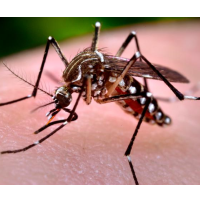Two More Reasons Besides West Nile Virus to Fear Mosquitoes in California
 Aedes aegypti, the yellow fever mosquito
Aedes aegypti, the yellow fever mosquito
One of two potentially deadly mosquitoes—neither native to California—has spread to 10 counties with the recent addition of Riverside and San Bernardino.
The California Department of Public Health (CDPH) is warning residents to be wary of mosquitoes that bite in the middle of the day or comfortably fly around the interior of a home. That’s not normal behavior for most mosquitoes, but these infectious pests are special—they can transmit yellow fever, dengue fever and chikungunya.
The yellow fever mosquito, Aedes aegypti, was spotted for the first time last month in San Bernardino and Riverside counties. It was first discovered in California in the counties of Madera, Fresno and San Mateo in 2013, before turning up later in Tulare, Kern, Los Angeles, San Diego, Imperial, Orange, and Alameda counties.
The other pest, Aedes albopictus, is known as the Asian tiger mosquito. It also showed up in September in Kern and San Diego counties before appearing in Los Angeles County. Aedes albopictus can transmit dengue fever and chikungunya. CDPH Director Karen Smith recommends that people report any black-and-white striped mosquitoes they spot.
“There is no vaccine or treatment for chikungunya or dengue fever,” Smith said in a CDPH release. Sixty-nine cases of dengue fever have been reported in California this year. Of the 120 people who contracted chikungunya, 91% got it in Latin America. One-third picked it up in Mexico.
The CDPH issued the standard recommendations for avoiding mosquito bites. Spray on lotsa DEET and other repellants, wear long sleeves and pants, put your shoes on, don’t let mosquitoes in your home, turn on the air-conditioning and don’t have pools of water lying about.
That last one could be the toughest of a tough lot. “Aedes aegypti mosquitoes can lay eggs in containers holding as little as a teaspoon of water, and eggs, which are laid just above the water line, can survive dry conditions for months,” the CDPH says.
Up to now, West Nile virus (WNV) has been the most noticed mosquito-borne infection in California. More than 400 cases have been recorded in at least 30 of the state’s 58 counties this year, and the virus has been detected in another 10. There have been 18 reported deaths.
The 801 human cases of West Nile last year were the most since 2003, when the disease first showed up in California. The CDPH said the excessive heat and drought were contributing factors. The department calls it an “emerging public health concern.” (pdf)
–Ken Broder
To Learn More:
Health Officials Warn of Mosquito-Borne Illnesses in California (by Sabra Stafford, Turlock Journal)
Yellow Fever Mosquito Found in Mission Viejo (by Jenna Chandler, Orange County Register)
Aggressive Mosquitoes Carrying Deadly Diseases Found in California (by Soumya Karlamangla, Los Angeles Times)
State Public Health Officer Warns of Invasive Mosquitoes Detected in California (California Department of Public Health)
Vector-Borne Disease Section Annual Report 2014 (California Department of Public Health) (pdf)
- Top Stories
- Controversies
- Where is the Money Going?
- California and the Nation
- Appointments and Resignations
- Unusual News
- Latest News
- California Forbids U.S. Immigration Agents from Pretending to be Police
- California Lawmakers Urged to Strip “Self-Dealing” Tax Board of Its Duties
- Big Oil’s Grip on California
- Santa Cruz Police See Homeland Security Betrayal in Use of Gang Roundup as Cover for Immigration Raid
- Oil Companies Face Deadline to Stop Polluting California Groundwater





